
M/S PRINSESSE MARGRETHE.
Byggd 1968 av Cantieri Navali
del Torrino e Riuniti S.P.A.
Riva Trigoso Genua.
Knop. 21,0.
Passagerare. 952.
Efter ombyggnad. 1100.
Hyttplatser. 506.
Efter ombyggnad. 698.
Bilar. 100.
Efter ombyggnad. 121.
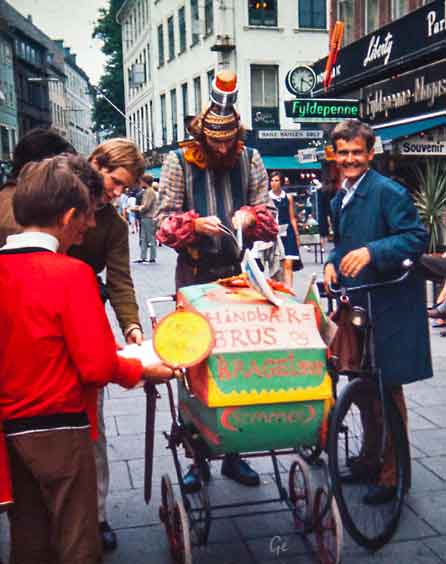
Jan Erik på Strøget i København
Københavns største indkøbsområde er centreret omkring
Strøget i hjertet af byen. Strøget er et Europas længste
gågader med et væld af butikker, fra budgetvenlige kæder
til nogle af verdens dyreste mærkevarebutikker.
Strækningen er 1,1 kilometer lang og går fra Rådhuspladsen
til Kongens Nytorv. Strøget er et kælenavn fra 1800-tallet og
dækker over gaderne Frederiksberggade, Nygade,
Vimmelskaftet og Østergade samt torvene Nytorv,
Gammeltorv og Amagertorv.
http://www.visitcopenhagen.dk/da/copenhagen/stroeget-gdk414471
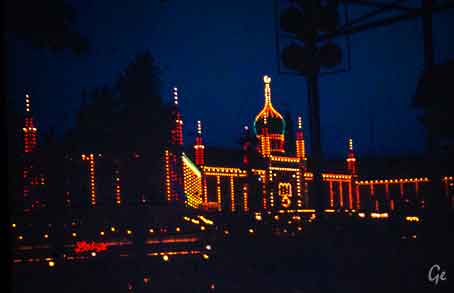
Tivoli Gardens amusement park in Copenhagen is a must
for all visitors to the city, young and old. Tivoli is located just
a few minutes walk from City Hall, and with the Copenhagen
Central Station as its nearest neighbour it is very easy to get to.
Tivoli Gardens was founded in 1843 and has become a
national treasure and an international attraction. Fairy tale
writer Hans Christian Andersen visited many times, as did
Walt Disney and many other celebrities, who all fell in love
with the gardens.
http://www.visitcopenhagen.com/copenhagen/tivoli-gardens-gdk424504
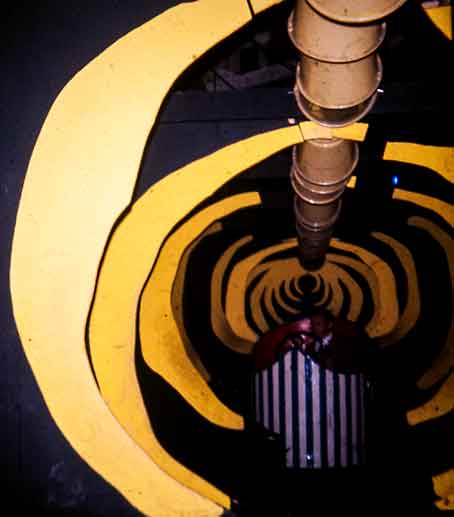
Spøkelsestoget


Rasthaus Kassel
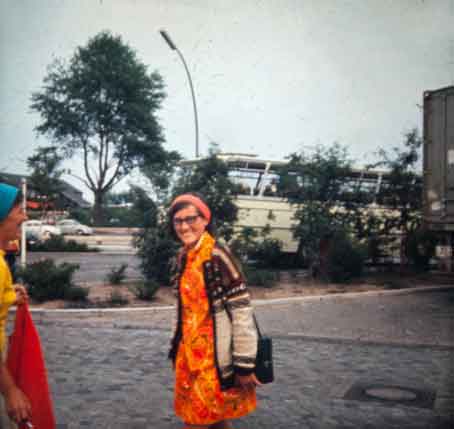
Grete og mor (Selma) på Rasthaus Hamburg
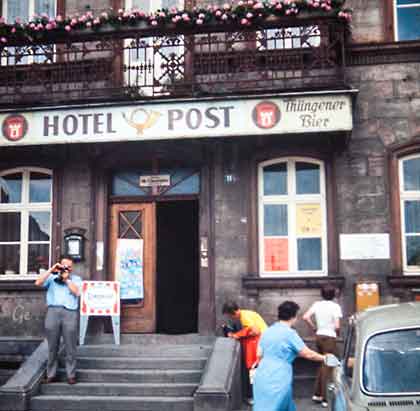
Overnatting hotel Post
Usikker på hvor.
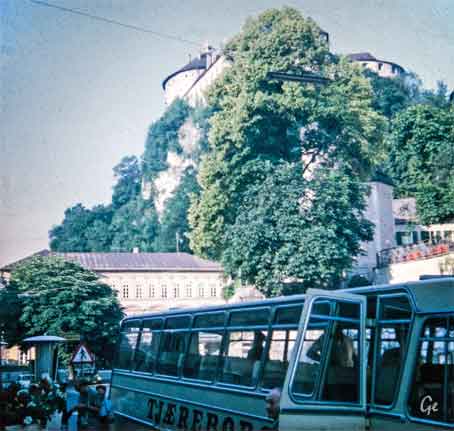
Kufstein is a town in the Austrian state of Tyrol, the
administrative seat of Kufstein District. With a population
of about 18,400, it is the second largest Tyrolean town
after the state capital Innsbruck.
The greatest landmark is Kufstein Fortress, first
mentioned in the 13th century.
https://en.wikipedia.org/wiki/Kufstei
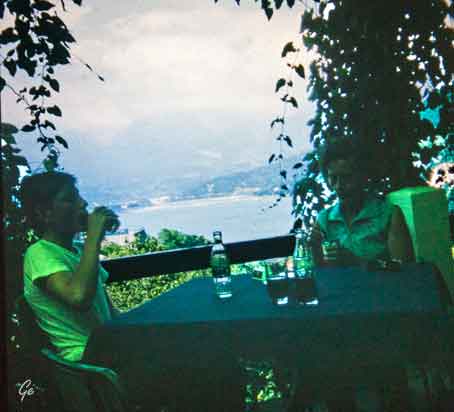
Kald cola ved Lago di Santa Croce
The Lago di Santa Croce is a semi-natural lake in the province of Belluno, Veneto, northern Italy. It is part of the communes of Alpago and Ponte nelle Alpi.
The lake is located at 386 metres (1,266 feet) ASL and currently
has an area of 7.2 square kilometres (2.8 sq mi), with an average
depth of 33 metres (108 feet).It was originally naturally a smaller
lake, but was expanded with a dam during the 1930s.
Outlets of the lake include the Piave. The area is quite a windy l
ocation and as such is a popular sailing, watersports and kitesurfing location.
(2.3.2020) https://en.wikipedia.org/wiki/Lago_di_Santa_Croce

Rialtobroa

The present stone bridge, a single span designed by
Antonio da Ponte, was finally completed in 1591.
It is similar to the wooden bridge it succeeded.
Two inclined ramps lead up to a central portico.
On either side of the portico, the covered ramps
carry rows of shops. The engineering of the bridge
was considered so audacious that architect Vincenzo Scamozzi predicted future ruin. The bridge has
defied its critics to become one of the architectural
icons of Venice.
https://en.wikipedia.org/wiki/Rialto_Bridge
The romantic city of Venice is located in the Veneto region
of Italy — one of the northernmost states.
This ancient and historically important city was originally
built on 100 small islands in the Adriatic Sea. Instead or roads,
Venice relies on a series of waterways and canals.
One of the most famous areas of the city is the world-renowned
Grand Canal thoroughfare, which was a major centre of the Renaissance. Another unmistakable area is the central square
in Venice, called the Piazza San Marco. This is where you’ll find
a range of Byzantine mosaics, the Campanile bell and, of course,
the stunning St. Mark’s Basilica. (2.3.2020)
https://www.italyguides.it/en/veneto/venice
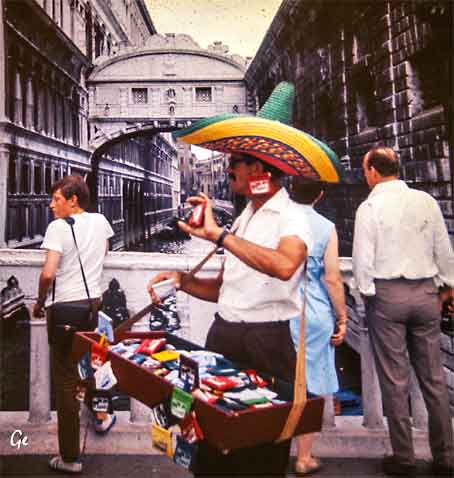
Sukkenes bro
The enclosed bridge is made of white limestone, has windows
with stone bars, and passes over the Rio di Palazzo and connects
the New Prison (Prigioni Nuove) to the interrogation rooms in
the Doge's Palace. It was designed by Antonio Contino (whose
uncle Antonio da Ponte had designed the Rialto Bridge) and was
built in 1600.
The view from the Bridge of Sighs was the last view of Venice
that convicts saw before their imprisonment. The bridge's name,
given by Lord Byron as a translation from the Italian "Ponte dei sospiri" in the 19th century, comes from the suggestion that
prisoners would sigh at their final view of beautiful Venice
through the window before being taken down to their cells.
In reality, the days of inquisitions and summary executions were
over by the time the bridge was built, and the cells under the
palace roof were occupied mostly by small-time criminals. In
addition, little could be seen from inside the bridge due to the
stone grills covering the windows.
https://en.wikipedia.org/wiki/Bridge_of_Sighs
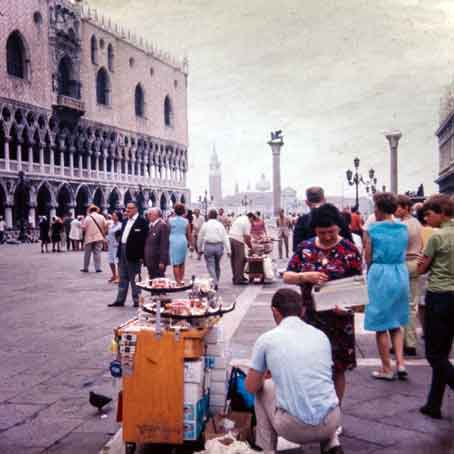
Dogepalasset
A masterpiece of Gothic architecture, the Doge’s Palace is
an impressive structure composed of layers of building
elements and ornamentation, from its 14th and 15th
century original foundations to the significant
Renaissance and opulent Mannerist adjunctions.
The structure is made up of three large blocks,
incorporating previous constructions.
The wing towards the St. Mark’s Basin is the oldest,
rebuilt from 1340 onwards.
The wing towards St. Mark’s Square was built in its present
form from 1424 onwards. The canal-side wing, housing the
Doge’s apartments and many government offices, dates from
the Renaissance and was built between 1483 and 1565.
https://palazzoducale.visitmuve.it/en/the-museum/doges-palace/the-palace/
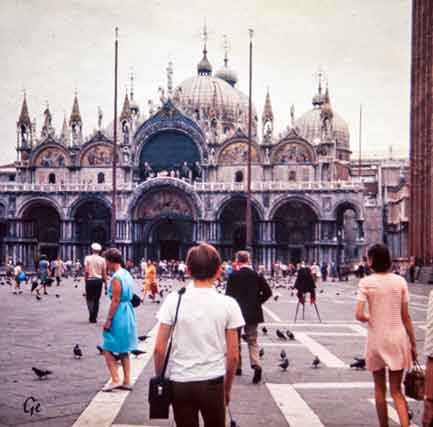
Marcuskirken og Marcusplassen
Relikviene etter evangelisten Markus ble brakt til Venezia
fra Alexandria 828. Kirken ble grunnlagt 1063 for å gi plass
til skrinet som rommet relikviene. To tidligere kirker på
samme sted er bygd inn i kirken, som stod ferdig 1094.
Den er en korskirke med kupler over korsmidten og
samtlige korsarmer.
Utformingen er sterkt preget av Venezias forbindelser med
det bysantinske riket. Bl.a. var Apostelkirken i Konstantinopel
bygd etter samme skjema. Det er antatt at både arkitekt og håndverkere har kommet fra Bysants.

Marcuskirken sett fra Klokketårnet
Selve kirkebygningen fikk liten innflytelse på den videre
utvikling i italiensk arkitektur. Større innflytelse fikk de b
ysantinske mosaikker som preger kirkens interiør.
Videre arbeider med kirken strakte seg frem til barokken,
noe som gjør det vanskelig å karakterisere dens stilpreg.
Ikke minst skyldes formingen av kirkens fasade mot
Markusplassen at den også blir regnet som et hovedverk
i italiensk gotikk.
https://snl.no/Markuskirken
San Marco Basilica, Italian Basilica di San Marco,
English Saint Mark’s Basilica, church in Venice that
was begun in its original form in 829 (consecrated in 832)
as an ecclesiastical structure to house and honour the
remains of St. Mark that had been brought from Alexandria.
of Venice, and his attribute of a winged lion later became the
official symbol of the Venetian Republic. San Marco Basilica,
built beside the Palazzo Ducale, or Doges’ Palace, also served
as the doge’s chapel. It did not become the cathedral church
of Venice until 1807. (2.3.2020)
https://www.britannica.com/topic/San-Marco-Basilica
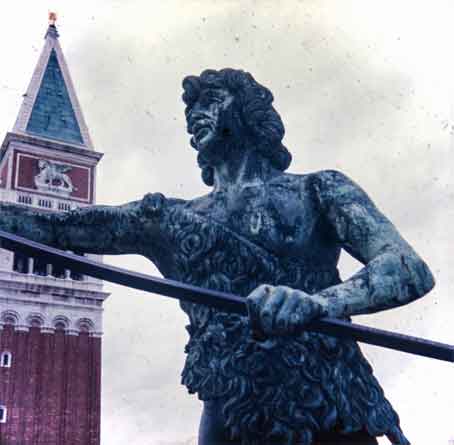
Klokketårnet
Mauro Codussi tegnet klokketårnet øverst mot kirken som
sto ferdig i 1499. Øverst ser vi to maurere som slår på en kjempeklokke.
Under der er Marcusløven på bakgrunn av blått og stjerner.
Under der sitter Maria med barnet på en liten balkong,
over et astronomisk ur. Og aller nederst finner vi porten
som fører til Rialto.
https://www.nrk.no/kultur/marcusplassen-i-venezia-1.3715252
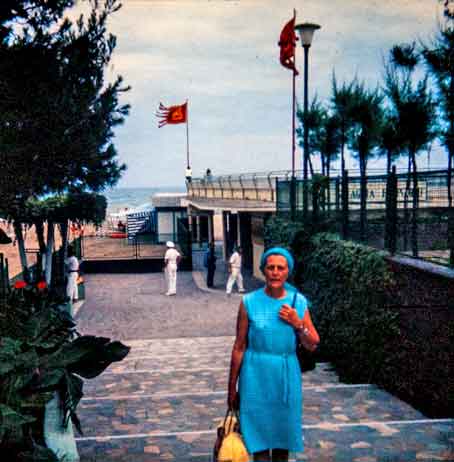
Venice Lido (Lido di Venezia) is an island, usually just
referred to as 'the Lido'. It is the narrow strip of land
which separates the central part of the Venetian lagoon
from the Adriatic Sea.
Once just a natural barrier, the Lido is now Venice's seaside.
It's also the origin of the word 'lido' as used in the
English-speaking world to describe bathing establishments.
It was developed as a seaside resort at the beginning of the
twentieth century, and has been popular for beach holidays
ever since.
http://www.italyheaven.co.uk/veneto/venice/lido.html
on the north side of the Piazza San Marco, at the entrance to
the Merceria. It comprises a tower, which contains the clock,
and lower buildings on each side. It adjoins the eastern end
of the Procuratie Vecchie. Both the tower and the clock date
from the last decade of the 15th century, though the mechanism
of the clock has subsequently been much altered. It was placed
where the clock would be visible from the waters of the lagoon
and give notice to everyone of the wealth and glory of Venice.
The lower two floors of the tower make a monumental archway
into the main street of the city, the Merceria, which linked the
political and religious centre (the Piazza) with the commercial
and financial centre (the Rialto). Today it is one of the 11
venues managed by the Fondazione Musei Civici di Venezia.
(2.3.2020)
https://en.wikipedia.org/wiki/St_Mark%27s_Clocktower
Marco), often known in English as St Mark's Square, is the
principal public square of Venice, Italy, where it is generally
known just as la Piazza ("the Square"). All other urban spaces
in the city (except the Piazzetta and the Piazzale Roma) are called campi ("fields"). The Piazzetta ("little Piazza/Square")
is an extension of the Piazza towards San Marco basin in its
south east corner (see plan). The two spaces together form the
social, religious and political centre of Venice and are
commonly considered together. This article relates to both of
them.
A remark usually attributed (though
without proof) to Napoleon
calls the Piazza San Marco "the drawing roomof
Europe".
(2.3.2020)
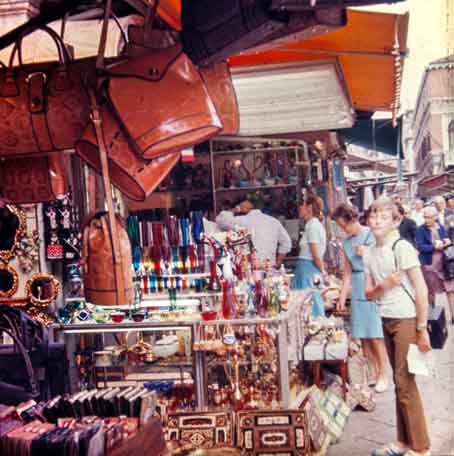
Loppemarked i Venezia
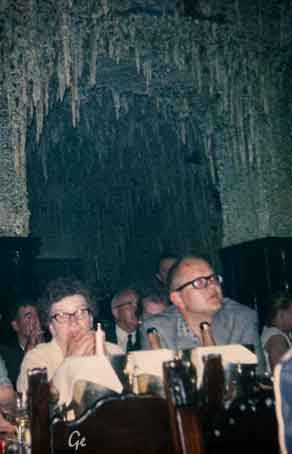 |
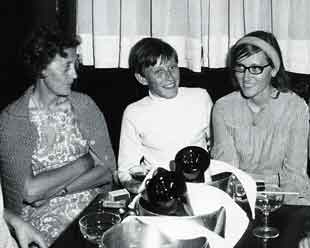 Middag på restauranten "la Grotta" i Venezia. Neste dagen fortsatte vi over til Jugoslavia. Det het fortsatt det i 1969. |
Etter Titos død i 1980 økte de etniske spenningene innenfor
Jugoslavias grenser. Problemene mellom republikkene kom fram til overflaten etter å ha blitt undertrykt av Tito i mange år.
Den nye grunnloven fra 1974 skapte mer kaos enn orden med tanke
på avgjørelser som skulle tas, og konfliktene mellom republikkene
ble uforsonlige. Ikke en eneste avgjørelse som kunne lettet på problemene ble tatt. Den konstitusjonelle krisen som ubønnhørlig
fulgte var til fordel for Slovenia og Kroatia og deres sterkere krav
om løsere bånd innen føderasjonen. Den økonomiske krisen som oppstod på samme tid forverret situasjonen.
https://no.wikipedia.org/wiki/Jugoslavia

Jan Erik og Grete utenfor Hotel Imperial
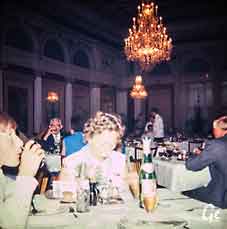 Middag på Imperial |
 27. juni 1969 |
Smart Selection Hotel Imperial Opatija embodies the city's
early days as a tourist destination. Built in 1885, this historic
Croatian property was originally named after Stephanie, a
Belgian princess by birth who later became Crown Princess
of Austria.
As the second hotel built on the Adriatic Sea, the Imperial is
constructed in Art Nouveau architectural style of the
Secession period. Its beauty has stood the test of time.
http://www.remisens.com/en/hotel-imperial
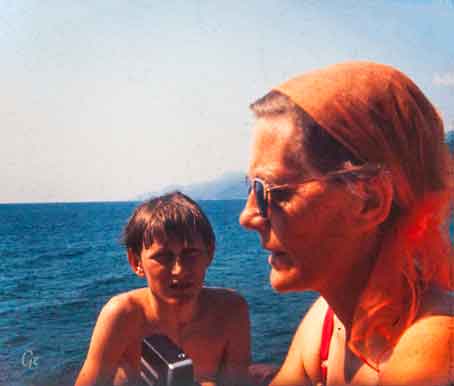
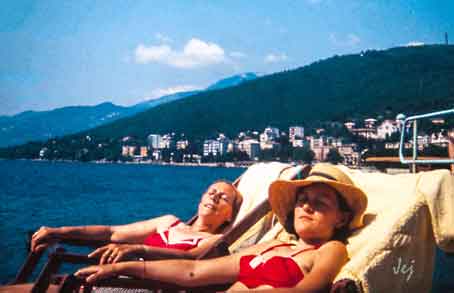
Opatija German: Sankt Jakobi; Italian: Abbazia; Hungarian:
Abbázia) is a town in western Croatia, just southwest of Rijeka on the Adriatic coast. As of 2011, the town had 11,659 inhabitants
in total, of which 6,657 lived in the urban settlement.
https://en.wikipedia.org/wiki/Opatija

Rijeka is the main city and county seat of the Primorje-Gorski
Kotar County. The city's economy largely depends on shipbuilding (shipyards "3. Maj" and "Viktor Lenac Shipyard") and maritime transport. Rijeka hosts the Croatian National Theatre Ivan pl. Zajc, first built in 1765, as well as the University of Rijeka, founded in
1973 but with roots dating back to 1632 and the local Jesuit
School of Theology.
Apart from Croatian and Italian, linguistically the city is home to its own unique dialect of the Venetian language, Fiuman, with an estimated 20,000 speakers among the autochthonous Italians, Croats and other minorities.
Rijeka - Wikipedia (22. februar 2023)
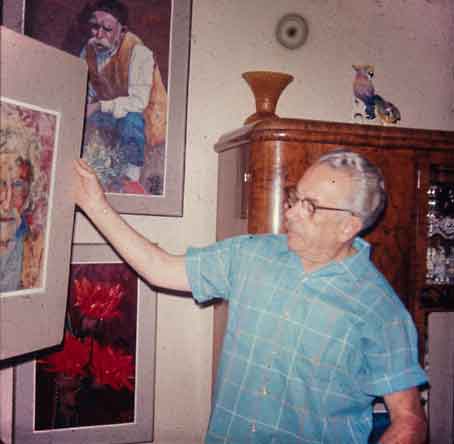
På besøk hos en kunstmaler i Rijeka
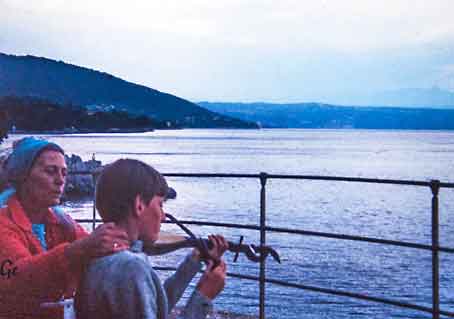
Lovran is a town located on the eastern rough slopes of the Ucka mountain. This is a town with a long and rich past with a
long tourism tradition. It is a typically Mediterranean town with narrow streets and houses built one next to another.
The town was named after the laurel tree that grows in the
town and its surroundings. Lovran has preserved its historic
core, built according the medievan urban conception.
In the past, the old town was encircled in walls on the
foundation of which houses were gradually built.
https://www.adriagate.com/Croatia-en/Lovran
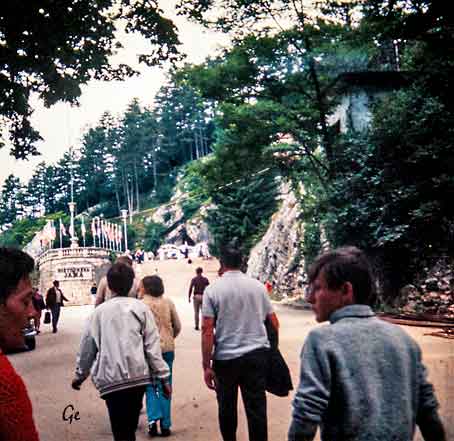
Utenfor Postojna-grotta
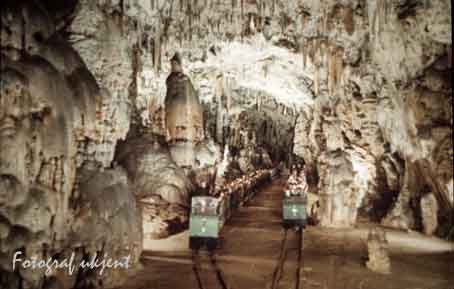 Postojna Cave (Slovene: Postojnska
jama; German:
Postojna Cave (Slovene: Postojnska
jama; German:
Adelsberger Grotte; Italian: Grotte di Postumia)
is a 24,340 m long karst cave
system near Postojna, southwestern Slovenia.

It is the second-longest cave system in the country
(following the Migovec System) as well as one of its
top tourism sites.
The caves were created by the Pivka River.
https://en.wikipedia.org/wiki/Postojna_Cave
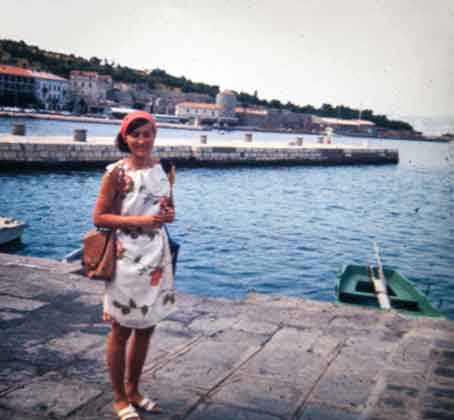
Senj, Kroatia

Senj - a tourist resort and port in the Velebit channel. The town
of Senj is located on the edge of a wooded slope at the foot of
the Velebit mountain bare rocks, from which a strong wind
called Bura blows in the winter. This region was used to cross
from the inland to the coastal area since ancient times.
https://www.adriagate.com/Croatia-en/Senj
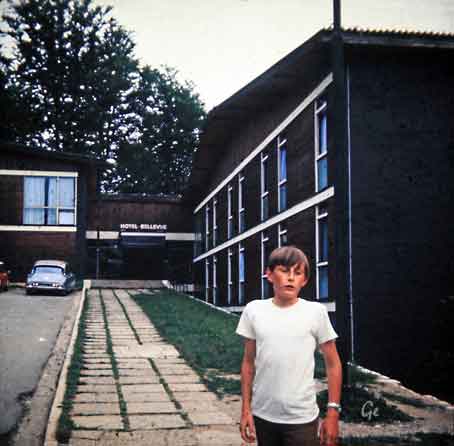
Hotel Bellevue, Plitvice
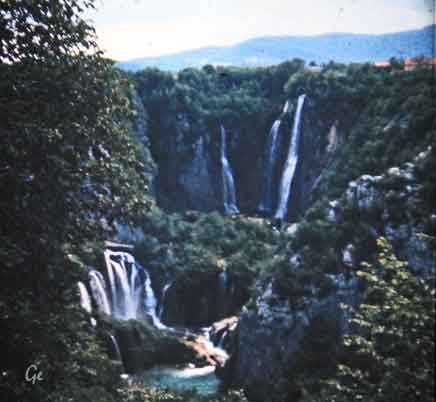
The Plitvice Lakes National Park, Croatia
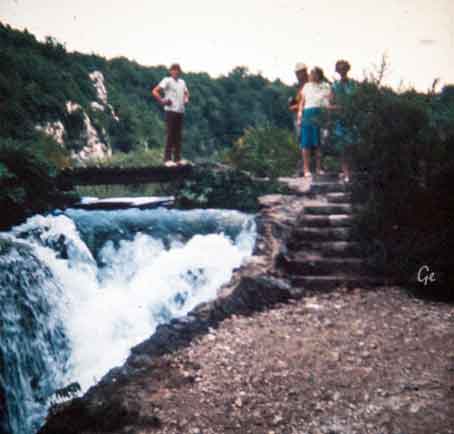
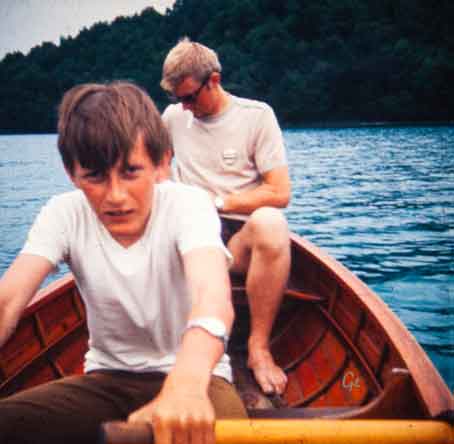
Jan Erik og reiselederen vår ror en tur på en av
sjøene i Plitvice Nasjonal Park.
The Plitvice Lakes National Park,
Croatia’s most popular
tourist attraction, was granted UNESCO
World Heritage
status in 1979. Located roughly halfway between
capital city Zagreb and Zadar on
the coast, the lakes are a
definite must-see in Croatia. (As confirmed by the
many
emails we’ve received!)
inter-connected by a series of waterfalls, and set in deep
woodland populated by deer, bears, wolves, boars and rare
bird species. The National Park covers a total area of
300 square kilometres, whilst the lakes join together
over a distance of eight kilometres.
http://www.visit-croatia.co.uk/index.php/croatia-destinations/plitvice-lakes/
Wien
Vienna’s history dates back to the first post-Christian century
when the Romans established the military camp Vindobona.
Today’s cityscape is characterised by the abundance of
baroque buildings created mostly under the rule of Empress
Maria Theresia and Emperor Franz Joseph who was largely responsible for the monumental architecture round the
Ringstraße.
http://www.austria.info/us/where-to-go/cities/vienna
Donau-parken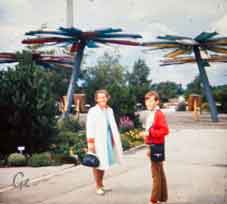
|
Under
the auspices of the 1964 Vienna International Garden Festival, a generous park area was created in 1963 and 1964 on an island between the Danube and the Old Danube, between the centre of Vienna and the districts of Floridsdorf and Donaustadt. The object of the exercise was to gradually clean up the existing site: a rubbish dump, https://www.wien.gv.at/english/ environment/parks/donaupark.html |
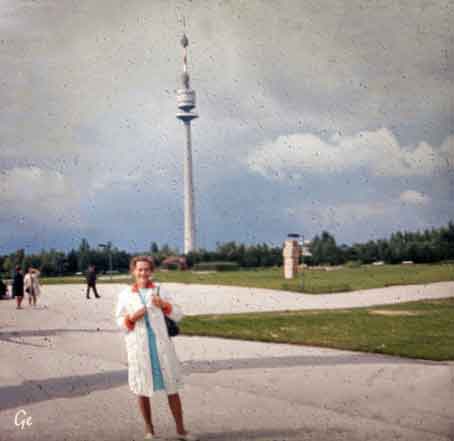
a former parade ground that was a notorious site of executions
during the Nazi years, and the "Bretteldorf" squatters' settlements.
Alfred Auer, Director of Vienna's Parks and Gardens at the time,
was commissioned to design the park.
He developed a many sided park area with special exhibition and
theme gardens typical of a garden festival, including a rose garden,
a lily garden, a nation´s garden, a Paracelsus herb garden, and a moorland garden.
The park's landmark is the 250 meters tall Danube Tower, which
offers a 360 degree view over the entire city. Today many of the
features of the garden festival have been dismantled or adapted
for other uses, such as a giant chess board, skatepark and a petting
zoo. The park has become a favourite for all ages.
https://www.wien.gv.at/english/environment/parks/donaupark.html
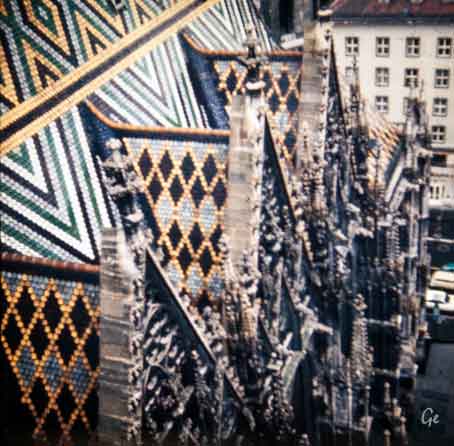
Stephansdomen
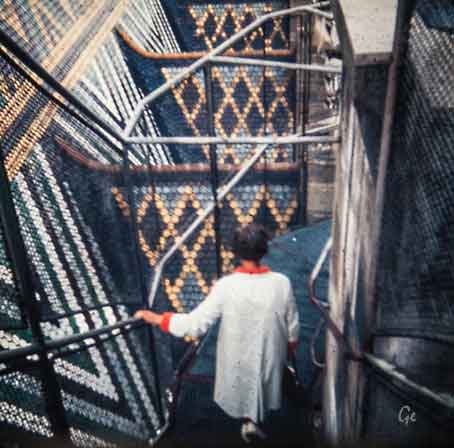
Adgang til tårnet via utvendig trapp.
Ikke noe for dem med høydeskrekk.
city’s history, with the initial foundation stone dating back
to 1137.
That original 12th-century church is no more, though the
current incarnation has its origins in the mid-13th century;
the main entrance door, for example, dates back to this time.
Sadly, Stephansdom survived the aerial bombings of WWII only for a fire in nearby buildings to spread to the cathedral in April 1945, destroying parts of the building.
(20. juni 2022) Stephansdom – St.Stephen’s Cathedral (visitingvienna.com)

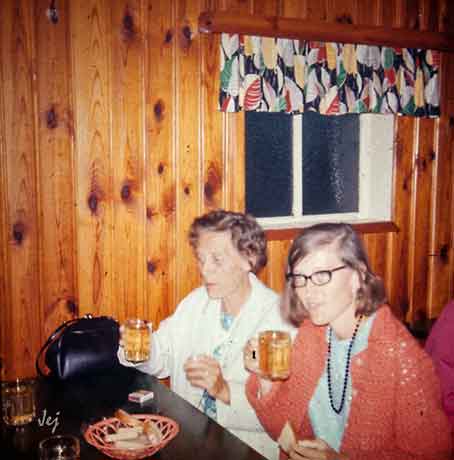
Besøk på en Heuriger Restaurant
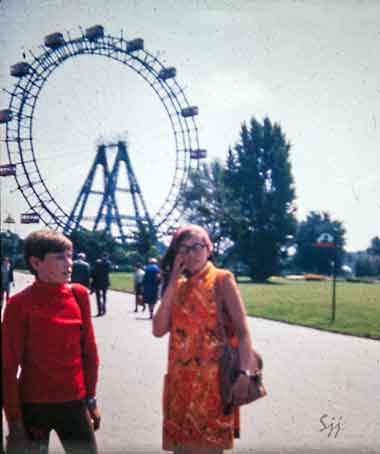
Pariserhjulet i Prater
given to a tavern in Eastern Austria, where a local winemaker
serves his new wine under a special licence in alternate months
during the growing season. The Heurige are renowned for their atmosphere of Gemütlichkeit shared among a throng enjoying
young wine, simple food, and - in some places - Schrammelmusik.
They correspond to the Straußwirtschaften in the German
Rheinland. Both have a bush of pine twigs hanging at the entrance when they are open.
https://en.wikipedia.org/wiki/Heuriger
The Prater was once imperial hunting ground and only
accessible for the aristocracy, until the Austrian Emperor Josef II donated the area to the Viennese in 1766 as a public leisure center.
And since Emperor also allowed the establishment of
restaurants and snack bars – small wonder that it didn’t take long
until the precursors of today’s Wurstelprater appeared on the
edge of the former aristocratic hunting grounds. Innkeepers,
coffee brewers, and gingerbread bakers (Lebzelter) hung out
their shingles; seesaws and merry-go-rounds as well as bowling
alleys were not far behind.
http://www.praterwien.com/en/prater/fun-in-vienna/history/
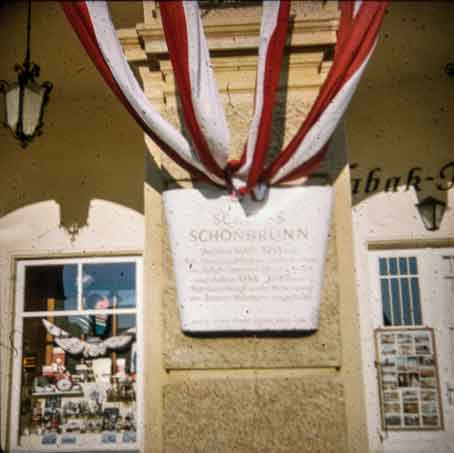

Schønbrunn slott
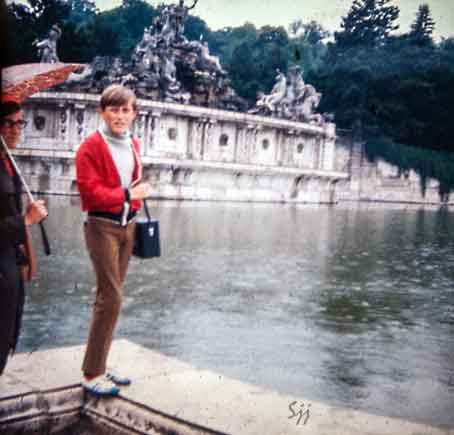
Schønbrunn slott
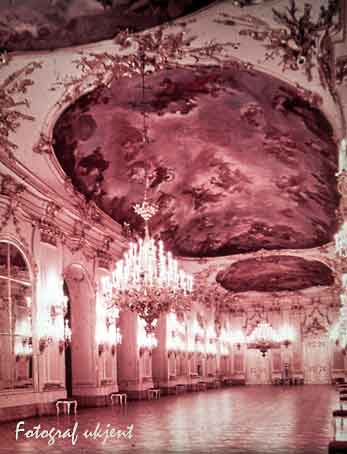
Schønbrunn slott
The history of Schönbrunn and the buildings that previously
stood on this site dates back to the Middle Ages. From the
beginning of the fourteenth century, the estate as a whole
bore the name of Katterburg and belonged to the manor of
the abbey at Klosterneuburg.
The estate boasted a corn-mill together with an arable
farm and vineyards. Over the following centuries numerous
lessees are documented, including a reference in 1548 to
one Hermann Bayer, mayor of Vienna, who extended the
property, transforming it into a substantial country estate.
https://www.schoenbrunn.at/en/about-schoenbrunn/the-palace/history/
out in close collaboration with Nikolaus Pacassi, whose
practical skills led to him taking a leading role in the project,
and eventually to his appointment as court architect in 1749.
Work commenced on the imperial apartments in the East Wing
with audience rooms and residential suites for Maria Theresa
and Franz Stephan, which were ready for occupation by 1746.
The coronation of Franz Stephan of Lorraine as Roman-German Emperor in Frankfurt in October 1745 probably provided
additional impetus to appoint what had become the imperial
summer residence with particular magnificence.
https://www.schoenbrunn.at/en/about-schoenbrunn/the-palace/history/

En ekstra stopp på grunn av feil med bussen
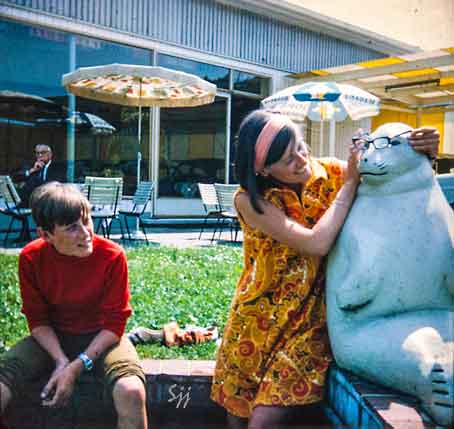

Siste overnatting ble på hotel Stadt Hamburg.
